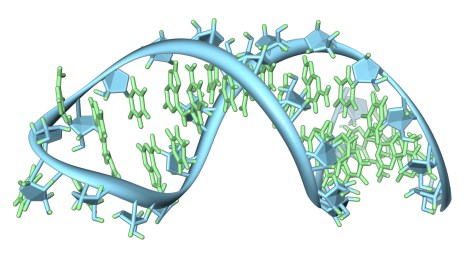Last week, I asked how different genetic engineering was from conventional breeding. My answer (to boil some 2,000 words down to three) was: just a little bit.
But there’s more than one way to think about this little bit of difference. I think it’s important to recognize — as we hash this out, as you try to convert your friends, or your local politician, or me — that there really are fundamentally opposed values here, and they influence how we see the same things. Two smart people with different perspectives might look at the same evidence, and come away with radically different conclusions about risk.
And so a couple of people suggested revisiting the conclusions I took home from my visit to Pam Ronald’s lab. One of these people was Jack Heinemann, a New Zealand scientist who works on risk assessment of genetically modified organisms.
One real difference between genetic engineering and good old sexual reproduction, Heinemann suggested, is that genetic engineering frequently creates bits of double-stranded RNA (imagine a free-floating chunklet of DNA). We don’t know if this happens with conventional breeding or not.

UCL Mathematical and Physical SciencesRNA.
I’m always tempted to dive into the science, as is my nerdific wont, but you don’t need to fully understand the science to understand the argument — and see why it’s so divisive. In short, this issue of double-stranded RNA is pretty representative: You could substitute any number of potential GM horror stories that people have dreamed up. However, if you do want a peek at the science, let me just offer you this lovely video from the people at Nature.
[protected-iframe id=”fd03b2bdbd3293196047ce573f562afb-5104299-50769480″ info=”http://c.brightcove.com/services/viewer/federated_f8/1399191810″ width=”510″ height=”550″]
Basically, Heinemann says, we know that we’re creating double-stranded RNA in genetically modified foods, and you can think up several scenarios in which it could be harmful.
When I asked Anastasia Bodnar of Biofortified (which generally favors genetic engineering) about this, she said that these scenarios didn’t worry her. You can dream up hypotheticals all day, but the world we live in is already full of these kinds of possibly dangerous unknowns. We’ve been living with double-stranded RNA since the beginning of time — the stuff is probably in every bite we fork into our mouths. Normal (non-engineered) rice, for instance, has lots of it; moreover, it has thousands of RNA sequences that match (and therefore might hypothetically interfere with) ones in the human body. So, given the ubiquity of double-stranded RNA, we must just be impervious to it. One of our several lines of defense: Stomach acid utterly destroys RNA, though there’s some preliminary evidence suggesting that some double strands might survive. The point is that we are up to our ears in the RNA of other species, so we must be well equipped to deal with it.
Well, Heinemann says (I’m not quoting him conversationally because he lives on the other side of the world and communicated in late-night emails — but here’s a quote from one of his papers):
Rice, of course, has a long history of safe use in the human diet. If rice produced a small RNA that was toxic, it would have been screened out of our diets thousands of years ago. The important point is that the safe use of a conventional plant with potential [small RNAs] does not extend to its GM counterpart.
This is where I imagine a pro-GE interlocutor starts pulling out his hair and exclaims: Gah! OK, maybe every small RNA in rice is thousands of years old, but maybe it was inserted yesterday! We don’t know. So why do you think that the terrifying black box of nature is any less likely to gin up a horrific scenario?
Anti-GMO: We know we are making double-stranded DNA with GM. We don’t know that it’s happening frequently in nature. So we should be more careful.
Pro-GMO: Maybe it does, maybe it doesn’t, and it almost certainly doesn’t matter. We’re almost certainly impervious.
Anti-GMO: But maybe it does — and if so, hoo-boy, we’ll all be sorry!
Pro-GMO: Oh, please — you are taking a bigger risk walking down the stairs.
Anti-GMO: Am not.
Pro-GMO: Are too. [and on forever and ever]
Rise above the details of my imaginary debate for a moment to notice the ground each side has staked out as a presumptive starting place. You have one side that sees humans as fragile and dependent on maintaining the nurturing environment in which they evolved. The other sees humans as tough survivors of a fundamentally chaotic environment. One side sees huge dangers in technologies that alter our surroundings. The other sees technological advance as a defense against nature red in tooth and claw.
I think we can all recognize that both positions make sense. Nature is abundant and nurturing. Also, it often wants to eat us. It’s not useful to argue that one is right and the other is wrong. But it is useful to recognize where we sit on this continuum if we hope to assess the risks and benefits of innovations in a clear-eyed way. (This is where I am, or this for all the dirty details.)
You can see this divide all over the GM food debate. Heinemann took me to task for taking the perspective of the technological optimist, for instance, with regards to the cauliflower mosaic virus promoter. (This is a bit of DNA that we’ve borrowed from a plant virus and slip into genomes along with genes, to boost their power.) I’d noted that we see the virus inserting a promoter out in wild and woolly nature all the time, and reasoned that, if that hasn’t caused any problems, an intentional and tested use of this natural tool was even safer. In other words: Humans are tough, we’re used to this sort of thing. But you could think of it in just the opposite way: We’re using this piece of virus in a whole new way, placing it into thousands of acres of crops every year. If something subtle went wrong in this case, it could cause problems that wouldn’t have showed up in nature.
So, to get back the question at hand, the evidence we have suggests that there is “a little” difference between GE and conventional breeding. But the interpretation of what “a little” means for perception of risk, and for public policy, varies wildly depending on people’s values.
The anti-GE people are angry that additional risk — no matter how distantly hypothetical — is being placed upon them without their permission. The pro-GE people are infuriated by what looks to them to be the defiance of a logical cost-benefit analysis — that is, why worry about this when there are much bigger risks all around? The former wants regulations to protect the sanctity of the environmental status quo from evil corporations. The latter wants the innovations to improve the environment, and fears evil regulations will impede them.
This doesn’t mean that values are the only thing that matters, or that any position can be legitimate. There are probably a lot of claims floating around out there that both Jack Heinemann and Pam Ronald would agree are phony. And there are a lot of us in the middle of this debate, inclined slightly to one side or the other, who want to become more familiar with the evidence for the risks and benefits before we make up our minds.
A true conversation can only occur when both parties come to the table ready to fight for their convictions, but also willing to question them. I find I’m much more persuasive if I’m also willing to be persuaded. Which is why I’m writing this.
A couple reminders: I promise to dig into the the big-picture issues of politics, and money, and ecology. Lots of people in the comments want to know about corporate influence over science and intellectual property. But there’s a couple other things that were brought up from the last few posts that I’d like to flesh out first. Remember, this is an iterative process: When I take up a new topic, that’s the beginning, not the endpoint — so if you have evidence that fills out the picture from my first pass, let me know in the comments below. Every day I’m learning new things from the yeoman’s work some readers have been doing there.
More in this series:
- The genetically modified food debate: Where do we begin?
- The GM safety dance: What’s rule and what’s real
- Genetic engineering vs. natural breeding: What’s the difference?
- Genetically engineered food: Allergic to regulations?
- Genetically modified seed research: What’s locked and what isn’t




